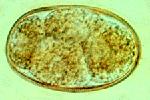Difference between revisions of "Ancylostomatoidea Structure and Function"
JamesSwann (talk | contribs) |
|||
| (6 intermediate revisions by the same user not shown) | |||
| Line 1: | Line 1: | ||
| − | {{ | + | {{OpenPagesTop}} |
| − | + | {{Taxobox | |
| − | = | + | |name =Ancylostomatoidea |
| − | + | |kingdom =Animalia | |
| − | + | |phylum =[[Nematodes|Nematoda]] | |
| − | + | |class =Secernentea | |
| − | + | |sub-class = | |
| − | | | + | |order =Strongylida |
| − | + | |super-family =[[Ancylostomatoidea]] | |
| − | + | |family =Ancylostomatidae | |
| − | | | + | |sub-family = |
| − | + | |genus = | |
| − | + | |species = | |
| − | |- | + | }} |
| − | | | ||
| − | |||
| − | |- | ||
| − | |||
| − | |||
| − | |- | ||
| − | | | ||
| − | | | ||
| − | |||
== General Appearance == | == General Appearance == | ||
| Line 29: | Line 20: | ||
Unlike the rest of the [[Strongyloidea]], the head is bent dorsally so that the buccal cavity forms a characteristic 'hook'. Members of the family have large buccal cavities which often contain teeth and cutting plates to allow the adult worms to embed their heads deeply into the mucosa of the small intestine. The large buccal cavity can be easily identified under the microscope and the configuration of teeth and cutting plates can be used to identify individual species. | Unlike the rest of the [[Strongyloidea]], the head is bent dorsally so that the buccal cavity forms a characteristic 'hook'. Members of the family have large buccal cavities which often contain teeth and cutting plates to allow the adult worms to embed their heads deeply into the mucosa of the small intestine. The large buccal cavity can be easily identified under the microscope and the configuration of teeth and cutting plates can be used to identify individual species. | ||
| − | Almost all hookworm eggs are oval in shape and around 50 um in diameter. The shell membrane is thin and transparent and, by the time the egg is passed in the faeces, it contains a segmented ovum at the 4 or 8 cell stage. In a tropical climate, the egg will hatch within 24 hours and only L1 larvae will then be detectable. | + | Almost all hookworm '''eggs''' are oval in shape and around 50 um in diameter. The shell membrane is thin and transparent and, by the time the egg is passed in the faeces, it contains a segmented ovum at the 4 or 8 cell stage. In a tropical climate, the egg will hatch within 24 hours and only L1 larvae will then be detectable. |
| + | |||
| + | |||
| + | {{review}} | ||
| + | |||
| + | {{OpenPages}} | ||
| + | [[Category:Ancylostomatoidea|A]] | ||
| − | [[Category: | + | [[Category:Expert_Review]] |
| − | |||
| − | |||
| − | |||
Latest revision as of 16:00, 5 July 2012
| Ancylostomatoidea | |
|---|---|
| Kingdom | Animalia |
| Phylum | Nematoda |
| Class | Secernentea |
| Order | Strongylida |
| Super-family | Ancylostomatoidea |
| Family | Ancylostomatidae |
General Appearance
The superfamily Ancylostomatoidea contains the 'hookworms', 1-2 cm long bursate nematodes which, together with the Strongyloidea and Trichostrongyloidea, belong to the order Strongylida.
Unlike the rest of the Strongyloidea, the head is bent dorsally so that the buccal cavity forms a characteristic 'hook'. Members of the family have large buccal cavities which often contain teeth and cutting plates to allow the adult worms to embed their heads deeply into the mucosa of the small intestine. The large buccal cavity can be easily identified under the microscope and the configuration of teeth and cutting plates can be used to identify individual species.
Almost all hookworm eggs are oval in shape and around 50 um in diameter. The shell membrane is thin and transparent and, by the time the egg is passed in the faeces, it contains a segmented ovum at the 4 or 8 cell stage. In a tropical climate, the egg will hatch within 24 hours and only L1 larvae will then be detectable.
| This article has been peer reviewed but is awaiting expert review. If you would like to help with this, please see more information about expert reviewing. |
Error in widget FBRecommend: unable to write file /var/www/wikivet.net/extensions/Widgets/compiled_templates/wrt69456f13953f02_55152395 Error in widget google+: unable to write file /var/www/wikivet.net/extensions/Widgets/compiled_templates/wrt69456f139a5f24_42695035 Error in widget TwitterTweet: unable to write file /var/www/wikivet.net/extensions/Widgets/compiled_templates/wrt69456f139f93d4_28427032
|
| WikiVet® Introduction - Help WikiVet - Report a Problem |
